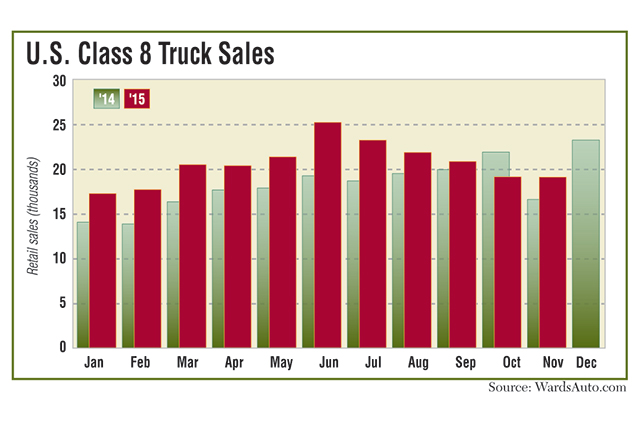Senior Reporter
Heavy-Duty Sales Up 15.1%

U.S. retail sales of Class 8 trucks were 19,231 in November, up 15.1% from a year earlier and the third-highest total for the month since 2000, WardsAuto.com reported.
Last month’s figure trailed only the November figures from the emissions pre-buy years of 2005 and 2006. It was also the third-highest monthly total of 2015. Through the first 11 months of the year, sales are up 15.7% to 228,024, compared with the 2014 period.
The sales picture in November was lopsided, Ward’s noted, with Daimler Trucks North America’s Freightliner brand selling 9,208 trucks, up 61.8% from last year. That set a record for monthly market share, as Freightliner garnered 47.9%. Freightliner had set the previous record in January with a 44.6% share.
“Our share is an example of the strength of our product portfolio. We want to thank our customers for their support,” David Giroux, DTNA’s director of corporate communications and corporate marketing, said in an e-mailed statement to Transport Topics.
Western Star, DTNA’s niche brand, saw sales rise 32.2% to 382 trucks, giving it a 2% share and its second-best performance based on percentage increase.
Also last month, Volvo Trucks’ sales jumped 15.1% to 2,192 units, giving it an 11.4% share of the November market.
“Volvo also experienced a strong month [in November] . . . with robust customer demand for our fuel-efficient, fully integrated trucks,” Magnus Koeck, Volvo’s vice president of marketing in North America, told TT. “Since orders precede sales, the trends in the overall Class 8 market are generally in line with our expectations.”
Mack Trucks, also part of Volvo Group, saw its sales decline 13.7% last month to 1,471, giving it a 7.6% market share.
“November’s sales results and the recent decrease in orders appear to be in line with our outlook,” said John Walsh, vice president of marketing at Mack.
Earlier this month, the company announced layoffs of about 400 employees, or 20% of its workforce, at its truck-making plant in Macungie, Pennsylvania, starting Jan. 25.
Mack and Volvo also told employees at their joint powertrain facility in Hagerstown, Maryland, on Dec. 15 that 200 employees there would be laid off.
At Kenworth Trucks, a unit of Paccar Inc., sales inched up 1.3% to 2,699 units for a 14% share of the market, second-highest for the month. Sales at Peterbilt Motors, also a Paccar division, tumbled 30.5%, year over year, to 1,857 trucks. The company had a 9.7% share in November.
Navistar International Corp. sales dropped 19.9% in November to 1,420 heavy trucks and a 7.4% share. However, its latest earnings report for the quarter and year ended Oct. 31 said it achieved “significant volume growth in dealer-led Class 8 heavy trucks” due to its conversion to selective catalytic reduction emissions technology, growing customer confidence and integrating leading technology with its partners.”
Neil Frohnapple, an analyst with Longbow Research, said he expects the North American Class 8 truck build rate in 2016 to be 250,000 units and called that a “bit more bearish than [some]. . . . That said, 250,000 is a very healthy Class 8 truck year. I think many would describe that as a normal replacement year, but certainly down from a peak number in 2015.”
ACT Research President Kenny Vieth said in a release, “We have to go back to the second half of 2012 to find a comparable period of imbalance, a period marked by anemic economic growth and strong U.S. Class 8 retail sales.”
He said that with “no apparent catalyst to trigger stronger economic growth, capacity additions are expected to remain ahead of freight creation at least until the end of 2015.”
Late last week, ACT reported that net orders in November were 16,770, which was “sharply below” figures from earlier in the year.
Some of the pullback on orders is related to the mixed economic environment in the United States.
For example, factory production has slipped this year as a stronger U.S. dollar and weaker overseas economies dampened demand for U.S.-made goods, Bloomberg News reported. However, stronger home construction and consumer spending have helped limit falloff in freight demand and orders.

